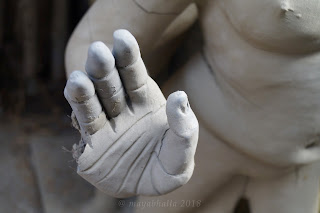Rivers, unlike seas, carry fresh water instead of salty water, and that
is why it is said that they bring life to the land. Ancient cities were born
and flourished on the banks of mighty rivers. It is this life-giving role of a river
that enables one to call it mother,
assigning most rivers in the world to the female gender. We all know the famous
Ganga and her sister the Yamuna; but today it seems fitting to talk about the
mysterious Saraswati. It is said, that parts of the Rig Veda were written on
her banks, and so, it is no small wonder that she is considered a river of
great importance, and mentioned in post Vedic texts as well as in Vedic Sanskrit.
It is also inevitable, that the river Saraswati, personified in time as a
Goddess, came to be known for her purity, as well as the teacher and patron of
students of wisdom, language, speech, music and the visual arts.
The Goddess Saraswti had several attributes that made her stand out
amongst the other Goddesses; the many stories of her birth are fascinating,
(any well-placed Google search will share this with you). However, as far as
origin stories go, I find this one to be my favourite.
‘This drying up of the river, (Saraswati), was a turning point in many of
the beliefs of the people, and is noted in the Upanishads. Here, this act is
explained in a myth. The Gods wanted someone to transport "fire" or
Agni to the sea. The gods entrusted the Sarasvati River to perform this task.
After gaining permission from her father Brahma, Sarasvati gathered up all her
waters, and formed a body. She then carried the fire to the sea. The myth holds
many symbolic meaning to the religious changes that were developing with the
emergence of the Upanishads, as well as the physical changes of the river. The
fire in reference, Agni, was the sacrificial fire and served as the link
between humans and the gods. Sarasvati's mission was to take this fire and
deliver it to the sea, which can be associated with the ocean of consciousness,
an aspect of the absolute. In doing so, the fire would become extinguished, and
at the same time, would be removed from the world of man. The gods choose the
Sarasvati River as the only one able to perform this task. Due to the purity of
her waters, and the fact that she is water, she was able to accomplish the
task.
In this event, Sarasvati has moved from a sacred
river, to a goddess; she is a goddess of purity. She has also deposed of the
ritualistic sacrifice as the sole mode of reaching the gods and the absolute.
As mentioned in the Upanishads, the sacrifice changes from fire and rituals, to
an internal process. In pursing knowledge, a sacrifice of the self is necessary
to exit from the karmic world. In this knowledgeable state, the person becomes
liberated through disciplines of the body, breathing, and mind. As a result,
from removing the sacrificial fire and replacing it with a sacrifice of the
self through obtaining knowledge, Sarasvati has now become the goddess of
knowledge and learning.’
(http://www.vishvarupa.com/print-information-about-saraswati.html)
And so, the River Saraswati was not only a bringer of life and culture
to a civilization, but also an agent of change; and finally a role model of
sacrifice as she gives herself up in the process of flowing to the ocean through the desert lands she is said to have dried up over, (or, is perhaps now, flowing
under).
I tell this story because, even now, the life of the Goddess is tied to
the river. Beside the famed Kumartuli in Kolkata, flows the Hooghly River, a distributary
of the Ganga. Every year, a trinity of Goddesses emerge from her womb;
Saraswati, Lakshmi and Durga. These three aspects of the divine feminine, by
turn take center stage in worship and then are returned to the sacred place
from where they came- the river.
Bamboo, cut down from groves upstream comes in on barges, and is deposited on
the banks of the river that flows by the train lines and the potter’s quarters
in Kumartuli. These lay submerged in the water, till they are softened and
bendable. These will form the skeleton of the Goddess Saraswati; the bamboo
structure upon which straw will be tightly bound, creating the muscles and
sinew of the Goddess. A mixture of clay dredged up from the bottom of
the river will coat the figure, becoming her skin. Her head will be sculpted
out of the same grey clay and affixed onto the body. More clay will be mixed
with jute and applied onto the body, creating the folds of her clothes. She
will be painted and decorated vibrantly, in her symbolic colours; her pets and
associated demigods will surround her. When all these elements are in place and her body is finally a fit home to house her spirit, her energy is invoked, a
mantra is whispered and she finally takes up temporary abode in this
beautifully appointed home.
At the end of the puja, Saraswati is returned home. When her spirit
returns to the ethers, her body made of earth and water is returned to the
river. She merges back into the earth, the universal mother, the womb. Like her
namesake, the ancient hidden river, she disappears, awaiting those diligent enough
to seek her out again.
A big thank-you to Manjit Singh Hoonjan, who took me through some
amazing spaces in his city; all the while reminding me of the importance of an
empty memory card. Those visiting Kolkata, please do look up Calcutta Photo Tours.
You won’t be disappointed.








